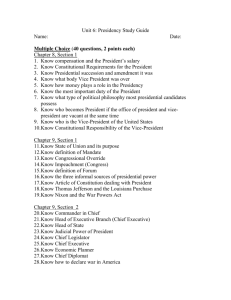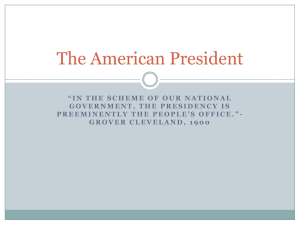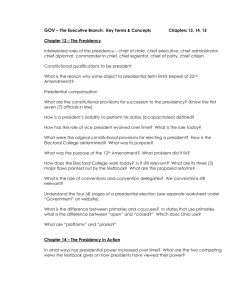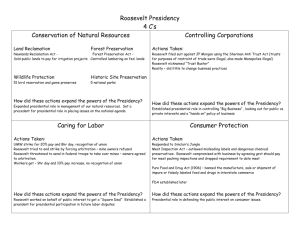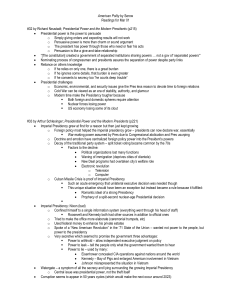The Presidency and the Constitution
advertisement
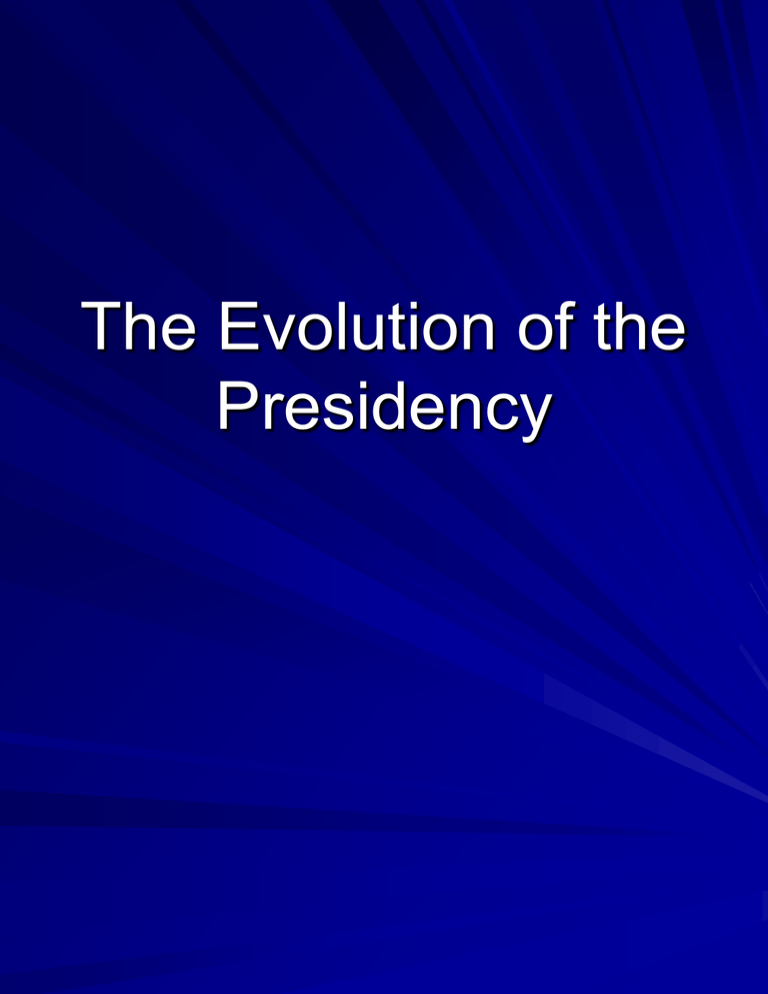
The Evolution of the Presidency Tidbits About the First President Washington spent the vast majority of his life outdoors, and reveled in horse riding and swordsmanship. Washington had little formal education, but longed to be wealthy. His father died when he was eleven, and he was raised by his aristocratic half-brother, Lawrence Washington. Lawrence owned much land, including Mt. Vernon. Lawrence died in 1752 making George the heir. Before the revolution, Washington married Martha Custis, a widow and heir to one of the largest fortunes in America. This made Washington one of the wealthiest. Washington was also granted substantial land (about 500,000 acres) by the Continental Congress after the Revolution. Washington was 6’2” tall, Martha was about 5’ tall. Washington never had children of his own, leading some to believe he was sterile. Fears of a hereditary monarchy assuaged by his inability to produce a blood heir. As president, Washington received a salary of $25,000, or about a million dollars in todays money. Of this, he spent an incredible 7 percent on alcohol. He especially liked Madeira and Port wine. While president he spent most of his time at Mt. Vernon. He splurged on a variety of luxuries, including leopard skin robes for his stable of matched horses. Washington did not have wooden teeth, but did have dentures. His dentures were made of hippopotamus bone, a very porous material, resulting in his teeth being black. This is why one seldom sees him smiling. He never chopped down a cherry tree or threw a dollar across the Rappahannock River. Washington had a VERY hot temper, during the Revolution “swearing himself blue in the face” and “cane whipping” his soldiers. Jefferson reported that Washington went into a rage at a cabinet meeting: “The president was much inflamed. [He] got into one of those passions when he cannot control himself… [yelling] that BY GOD he had rather be in his grave than in his present situation.” George Washington died at age 67, in December 1799, about three years after the end of his presidency. He died of a cold, or pneumonia, or strep throat, or ??? It is unclear from contemporary accounts. The men attempting to save him were, like most 18th Century physicians “quacks.” Over Martha’s protests, the bled him four times, made him drink a concoction of molasses, vinegar, and butter. They also filled him with laxatives trying to purge his foundering system. However, they only succeeded in forcing the poor man to spend his last hours on earth on a chamber pot. Washington was initially buried in a very modest hillside family mausoleum (a rotten wooden door today) at Mt. Vernon. He was reinterred at a better site at Mt. Vernon in 1837. Still, when compared with the tombs of other great leaders, Washington’s tomb is very modest. Mechanisms for Changing the Presidency Expansion of the presidency, both the size and power of the institution, has been enabled by the vagueness and imprecision of the Constitution with respect to presidential duties. Some would argue that this lack of clarity was precisely what the founding fathers intended so that the presidency could evolve through time. There have been two mechanisms for changing the presidency through time. – informal actions on the part of presidents – formally altering the office through constitutional amendment, statute, or formal presidential action such as issuing an executive order. We can also make a distinction between change resulting from presidential action and the actions of others. Changing the Presidency by Informal Presidential Action Washington probably had more influence over the shape of the presidency than any other president. He quickly filled in the “silences” of the Constitution by establishing precedents. The Constitution made no provision for an advisory body to the president. This was left vague intentionally with the statement “request the opinion in writing” of those in the executive branch. Washington turned to his Department Heads for advice to establish a “cabinet” like government. He went beyond the Constitutional charge to “request the opinion in writing”. He persuaded Congress to allow him to call for resignations of executive branch officials. Washington was not a highly educated man. However, he understood his limitations, relying heavily on his cabinet, and particularly on Treasury Secretary Alexander Hamilton in both domestic and foreign policy. He had a long-standing relationship with Hamilton, who had been is aide-de-camp during the Revolution. In this regard, the Constitution invests the president with authority to “recommend to their consideration [Congress] such measures as he shall judge necessary and expedient”. However, Washington expanded this authority by allowing his Treasury Secretary Alexander Hamilton to make such recommendations directly. Hamilton issued three reports to Congress during Washington’s first administration. On January 9, 1790 Hamilton issued the First Report on Public Credit, proposing that the federal government assume all debts incurred as a result of the American Revolution. It was adopted. On December 13, 1790 Hamilton issued the Second Report on Public Credit and proposed the establishment of a national banking system to support business activities. It was adopted. On December 5, 1791 Hamilton issued the Report on Manufactures, recommending policies to protect through tariffs and subsidies wealthy individuals who would expand American commerce. It was partially adopted after initial opposition. (Financial panic, scandal, and Indian Washington established the principle of supremacy of the national government and presidency in matters of public order. Hamilton’s Second Report called for an excise tax on distilled spirits to provide funding for the debt and bank plans. This sparked rebellion. Washington called up the militias to quell the Whiskey rebellion, and enlisted the state of Pennsylvania to inform him of the activities of pirates. Washington issued the first proclamation, the observance of Thanksgiving. Washington established the symbolic superiority of the presidency and national government to state governments receiving state officials but never visiting state capitols. Washington also began the practice of not seeking the advice of the Senate on appointments and Treaties, but obtaining the Senate’s consent. Washington established the informal power of “executive privilege,” or withholding requested information from Congress, the courts, or the public. Washington established the superiority of the presidency in matters of foreign affairs. When France and England began fighting after the French Revolution started in 1789, he chose to “declare neutrality”, in spite of France’s support during the Revolution. This greatly displeased Southern states and the Democratic-Republicans who favored France. A constitutional power to “declare neutrality”? He negotiated the first executive agreements (not treaties) with Spain allowing American ships to navigate the Mississippi river. He persuaded Congress to build up the navy to combat pirates raiding American shipping. He established the precedent of two presidential terms, though he hadn’t necessarily intended to. He did not run for a third term because of health concerns. Died three years after leaving office. Washington did not recognize a need for political parties and warned against partisanship in his farewell address. However, he behaved in what some would consider quite partisan way in the Jay Treaty controversy. See the first chapter of Wood’s 2009 book, The Myth of Presidential Representation for an extensive discussion. Washington went to Alexander Hamilton for advice on the Jay Treaty, leading Jefferson and Madison, who had offered opposing advice to begin forming the first opposition party, the Democratic-Republicans in 1795. Corwin estimates that 1 of every 3 presidents has been responsible for expansion of executive authority through time. Still some presidencies have been more expansive than others. Among the more important changes through time are the following. Jefferson used his prerogative power to negotiate and make the Louisiana Purchase. While Jefferson was a strict constructionist, there is no Constitutional power for the president to make such purchases. Presidential Veto. Andrew Jackson expanded the rationale for using the presidential veto. Using the veto he effectively killed the Second National Bank which he thought was corrupt. Executive Orders-Administrative orders from the president that have the force of law so long as they are consistent with the Constitution and law. Executive Agreements- International agreements that have the same effect as a treaty so long as the agreement is consistent with the Constitution, law, and pre-existing treaties. Case Act limits. Signing Statements - A signing statement is a written pronouncement issued by the President of the United States upon the signing of a bill into law. James Monroe issued the first. Until the 1980s, signing statements were generally triumphal, rhetorical, or political proclamations and went mostly unannounced. Until Ronald Reagan became President, only 75 signing statements had ever been issued; Reagan and his successors George H. W. Bush and Bill Clinton produced 247 signing statements among the three of them. As of January 30, 2008, George W. Bush had signed 161 signing statements challenging over 1,100 provisions of federal law. See http://www.coherentbabble.com/listGWBall.htm On March 9, 2009, President Barack Obama ordered his executive officials to consult Attorney General Eric Holder before relying on one of George W. Bush's signing statements to bypass a statute. Obama had issued 29 signing statements as of as of May, 2014. See http://www.coherentbabble.com/listBHOall.htm Through the State of the Union address presidents now present a coherent legislative agenda for Congress to consider. This started arguably with Theodore Roosevelt (The Square Deal) , though some would date it to Woodrow Wilson (The New Freedom). The State of the Union was delivered personally to Congress during the Washington and Adams administrations. Jefferson discontinued the practice in 1801, considering it too monarchical. From 1801 through 1913 these were delivered as written messages. Woodrow Wilson renewed the practice of delivery in person in 1913. Read the addresses here http://www.presidency.ucsb.edu/sou.php Moe argues that there is a natural tendency of presidents to seek greater authority and more control over administration. The rational choice argument is that it is a matter of presidential self interest to want to control the instruments of power. Changing the Presidency by Formal Means Constitutional Amendments-Seven amendments pertain in whole or in part to the presidency. http://avalon.law.yale.edu/18th_century/amend1.asp – 12th Amendment (1804) changed the mode of electing the president to take account of political parties. – 14th Amendment (1868) restricted former Confederates from serving as president or presidential electors. The due process clause is also a constraint on presidential action. – 20th Amendment (1933) changed the period of service of the president from March 4 to January 20th and provided for presidential succession. – 22nd Amendment (1951) provided for term limits. – 23rd Amendment (1961) provided representation for the District of Columbia in presidential elections. – 24th Amendment (1962) provided voting rights in presidential elections free of taxation. – 25th Amendment (1967) elaborated on presidential succession and defined presidential disability. Changing the Presidency by Statute: Expanding Presidential Power, some examples. – Budget and Accounting Act of 1921 – Reorganization Act of 1939 – Administrative Procedure Act of 1946 – Employment Act of 1946 – National Security Act of 1947 Changing the Presidency by Statute: Restricting Presidential Power , some examples. – The Pendleton Act of 1883 providing for a merit system. This restricted the president’s ability to remove officials. – Case Act of 1972 required the president to report international agreements to Congress. – The War Powers Resolution of 1973 was passed over President Nixon’s veto and limited the president’s ability to commit American troops to foreign soil. – Congressional Budget and Impoundment Act of 1974 limited presidential budget power. – Habeas Corpus Restoration Act of 2007granted habeas corpus rights to Guantanamo detainees. Changing the Presidency by Executive Order – Various executive orders have been used to create federal agencies, such as the Environmental Protection Agency (Nixon). – EO 12291 providing for cost-benefit analysis of new rules promulgated by federal agencies. – See http://www.presidency.ucsb.edu/executive_ orders.php Changing the Presidency by Court Decision – Ex Parte Milligan (1866) - President Lincoln and trials under martial law when there were functioning civil courts deemed illegal. – Humphrey’s Executor vs. U.S. (1935) Restricted president’s removal power – Youngstown Sheet and Tube Co. vs. Sawyer (1952) -Nullified Truman’s seizure of the steel mills – U.S. vs. Nixon (1974) -Restricted executive privilege – Hamdan vs. Rumsfeld (2006) -Denied Congress and president power to strip civil courts of jurisdiction over cases involving detainees at Guantanamo. Presidential Power Has Increased Through Time. Why? Wars Larger Society and Economy Meant Larger Government and Stronger Presidency Growth of Corporate Power in the Nineteenth Century Increased Presidential Leadership Changing Public Expectations for Government and the Presidency after the New Deal Interest Group Politics Meant Greater Demands on the Presidency Changing Judicial Doctrines Implied Presidential Policymaking Congressional Demands on the Presidency Bureaucratic Inertia Implied Growth the Presidency Presidential Thrust for Centralization Pre and Post Modern Presidencies It can be argued that the modern presidency began in the 20th century with the Franklin D. Roosevelt administration. However, the date of the transition to expanded presidential power is a matter for debate. A good case can be made that it began with Theodore Roosevelt or with Woodrow Wilson. Four factors distinguish the modern presidency from all past presidencies. – A greater presidential role in policy making – A stronger presidential relationship with the mass public – A greater presence in the realm of international politics – Expanded presidential staff Only the last of these came with the Franklin D. Roosevelt administration. Teddy Roosevelt was the first president since Washington to attempt cultivating a direct role with the mass public. However, growth of the mass media has made this more important. F. D. Roosevelt and radio. J.F. Kennedy and television. World politics-Teddy Roosevelt sent the navy on a “world tour”, and Woodrow Wilson was an active and some would say the primary force in negotiating the Treaty of Versailles that ended World War I. However, the U.S. became dominant world player after World War II. Arguably,Wilson was the first president to send Congress a comprehensive legislative agenda. By 1953 the tradition had become so entrenched that Eisenhower was soundly criticized for not submitting one. Expansion of presidential staffing did not occur until the Franklin D. Roosevelt administration and the recommendation of the Brownlow Commission for creating the Executive Office of the President. Staffing the Executive George Washington established a cabinet of four men to provide advice on the core affairs of government. He chose Thomas Jefferson as Secretary of State. Jefferson was a natural choice, since he had been ambassador to Paris at the time of the convention. There were three other Cabinet members, all of whom were strong Federalists. Alexander Hamilton was Secretary of Treasury, Henry Knox was Secretary of War, Edmund Randolph was Attorney General. Washington’s vice president was John Adams, also a strong Federalist. In 1791 when Washington prepared to leave the capitol city, he instructed the Vice President, Chief Justice, Secretaries of State, Treasury, and War to consult on governmental matters during his absence. These were the primary advisors to the president and their offices were quite small. The principal officers in each of the executive departments" are mentioned in Article II, Section 2, Clause 1 of the Constitution. However, there is no specific authorization for a cabinet in the Constitution. The presidency has evolved through time from a tiny office with no support staff to a very large bureaucracy. From Stillman an account from a foreign visitor at the War Department-" The government officials were as simple in their manners as ever. I had occasion to call upon McHenry, the Secretary of War. It was about 11 o'clock in the morning when I called. There was no sentinel at the door, all the rooms, the walls of which were covered with maps, were open, and in the midst of solitude I found two clerks each sitting at his own table, engaged in writing. At last I met a servant, or rather the servant, for there was but one in the house, and asked for the Secretary. He replied that his master was absent for the moment, having gone to the barber's to be shaved. Mr. McHenry's name figured in the State Budget for $2,000, a salary quite sufficient in a country where the secretary of War goes in the morning to his neighbor, the barber, at the corner, to get shaved. I was as much surprised to find all the business of the War Office transacted by two clerks, as I was to hear the the Secretary had gone to the barber's." For the first 70 years Congress did not even provide the president with secretarial support. Wrote their own speeches and answered their own correspondence. Most employed aides and paid them out of their own pockets. Frequently they were related to the president. Were usually young and undistinguished. In 1857 Congress enacted a special appropriation for a personal secretary to the president, but the position was of little importance at the time. In the 20th Century, beginning with Theodore Roosevelt the role of secretary increased in importance. Dealt with the press and planned the presidents schedule. Also, the size of the White House staff began to increase. Benjamin Harrison (1889-1893) housed his entire staff on the second floor of the White House; separate offices were constructed during McKinley’s administration (1897-1901; the West Wing of the White House was completed in 1909 to house the staff. Of course, this was at the end of the Theodore Roosevelt administration. Herbert Hoover doubled the number of administrative aides from 2 to 4 and was also helped by more than 40 others, including clerks, typists, messengers, etc. Roosevelt expanded it still further. In 1939, Franklin Roosevelt appointed the Brownlow Commission to advise the president on how to efficiently and effectively deal with a bureaucracy that had grown quite large through time. Following the Brownlow Commission’s recommendation, the president created the Executive Office of the President by executive order to assist in running the government. Note that the Brownlow Commission consisted of three members. Louis Brownlow, Charles Merriam, and Luther Gulick. All were prominent political scientists of the time. Go to the hot links to explore their areas of expertise. Some of the most important committee recommendations were creating presidential aides to deal with the administrative tasks assigned to the President. It also suggested that the President should have direct control over the administrative departments. In its third suggestion, the committee said that the managerial agencies - The Civil Service Administration, the Bureau of the Budget, and the National Resources Board - should be part of the Executive Office. Read a summary of the report here. Only two of the committee’s recommendations were adopted by Congress through the Reorganization Act of 1939. However, the Act gave President Roosevelt executive authority to make changes so that most of the various agencies and government corporations were organized within various cabinet level departments, greatly improving accountability among the various agencies. By executive order, the president acted to create the Executive Office of the President and also created an advisory group of six executive level assistants. The current White House staff consists of around 460 people, with another 100-150 detailed to it for specific assignments. See who these people were in 2014 by clicking here. The Executive Office of the President now consists of around 4,000 people, the number varying across different administrations and as new offices come and go. Click here for the current organization of EOP. With about 2.7 million civilian employees, the Federal Government, excluding the Postal Service, is the Nation's largest employer. Interestingly, the size was larger (about 3 million) during the Reagan-Bush I era, but declined during Clinton and later (about 2.7 million). See here for a time series from 1962. About 85 percent of Federal employees work Salary Scales for Federal Civilian Employees A more complete picture of the characteristics of federal employees is here. Paul Light reported (click here) that the true size of the federal government was about 12.1 million people in 2002, including everyone who draws a salary paid for by the federal government. This includes the postal service (875,000), the military (1,456,000), contractors (5,168,000), and grantees (2,860,000). However, his figure does not include state and local employment mandated by federal law. Of course, that was 14 years ago, so what is it now? Here is a Congressional Research Service Report from 2011 that informs on change since 2002 and current characteristics. http://assets.opencrs.com/rpts/RL34685_2011041 9.pdf At this link you can see the current organization of the entire federal government of which the presidency is a part. http://www.firstgov.gov/Agencies/Federal/Executi ve.shtml History of Department Level Change 1789- Department of State, Department of Treasury, Department of War, Post Office, Attorney General 1798- Department of Navy 1849-Department of Interior 1862-Department of Agriculture 1903-Department of Commerce and Labor 1913-Department of Commerce, Department of Labor 1947-Department of Defense 1953-Department of Health, Education, and Welfare 1965-Housing and Urban Development 1966-Transportation 1977-Energy 1980-Health and Human Services 1980-Education 1988-Veteran’s Affairs 2002-Department of Homeland Security Each presidency has seen expansion in the EOP as a function of both presidential and congressional interests. The Bureau of the Budget was created in 1921 to help the president with the budgeting function. It is now called the Office of Management and Budget. This very important office helps the president with budgeting, efficiency management, legislative clearance, rulemaking oversight, and a variety of other functions. The Council of Economic Advisors was created in 1946 to assist the president with implementation of the Employment Act of 1946. The National Security Council was created in 1947 to advise the president on matters of national security. The Office of Personnel Management was created in 1980 to help the president with staffing the large federal bureaucracy. Various presidents have also expanded EOP as a result of more personal interests. For example, George H.W. Bush established the Office of National Drug Control Policy in response to campaign promises to control the drug trade. George W. Bush created the Office of Faith Based Initiatives in response to promises made to the Christian right. Discussion Pre-modern presidencies are often thought of as clerks. Woodrow Wilson’s book entitled Congressional Government. Post modern presidencies are characterized by increased expectations for presidential leadership and increased presidential capacity to lead. Presidents are held accountable for their leadership and policies. There are at least two views of the president’s ability to satisfy the increased expectations. Neustadt argues that there is an “expectations gap” between what people expect of a president and the presidents ability to deliver. The president’s ability to lead is grounded in skill, reputation, and prestige which determine the president’s power to persuade. The president is highly constrained In contrast, Moe sees the presidency as possessing significant resources for leadership. Structural advantages relative to Congress. Information and expertise advantages. Unilateral initiative and actions. Politicization of the bureaucracy through appointments. Centralized decision making processes such as regulatory review. Context may be important to presidential power. The stage of the electoral cycle. Power and the ability to accomplish things is greater at the beginning of the president’s term. Congressional elections impede presidential power as members of Congress become more responsive to constituents. First term/second term effects. Lame ducks. Steve Skowronick suggests that there is a concept that crosses multiple administrations called “political time”. Political time relates to the alignment of forces facing the presidency and his relation to those forces. – Reconstruction presidencies- Here the ruling order is vulnerable and the president opposes that ruling order. (Jefferson, Jackson, Lincoln, FD Roosevelt. – Articulation presidencies- Here the ruling order is resilient and the president is affiliated with the ruling order.(Monroe, Polk, Lyndon Johnson, George H.W. Bush.) – Disjunctive presidencies- Here the ruling order is vulnerable and the president is affiliated with the ruling order.(John Adams, John Quincy Adams, Pierce, Hoover, Carter) – Preemption presidencies- Here the ruling order is resilient and the president is an opponent of that ruling order. (Tyler, Andrew Johnson, Woodrow Wilson, Richard Nixon, William J. Clinton)

